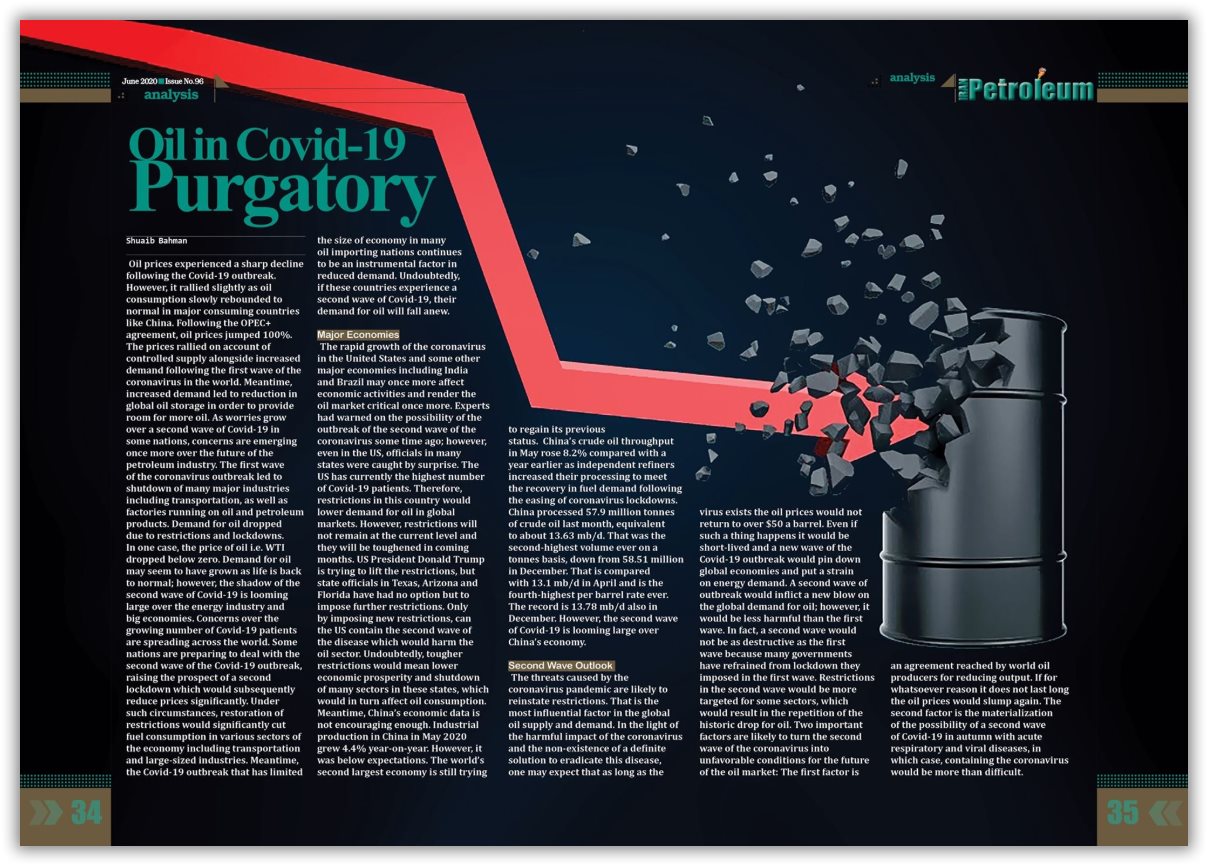Oil in Covid-19 Purgatory
Shuaib Bahman
Oil prices experienced a sharp decline following the Covid-19 outbreak. However, it rallied slightly as oil consumption slowly rebounded to normal in major consuming countries like China. Following the OPEC+ agreement, oil prices jumped 100%. The prices rallied on account of controlled supply alongside increased demand following the first wave of the coronavirus in the world. Meantime, increased demand led to reduction in global oil storage in order to provide room for more oil. As worries grow over a second wave of Covid-19 in some nations, concerns are emerging once more over the future of the petroleum industry.
The first wave of the coronavirus outbreak led to shutdown of many major industries including transportation, as well as factories running on oil and petroleum products. Demand for oil dropped due to restrictions and lockdowns. In one case, the price of oil i.e. WTI dropped below zero.
Demand for oil may seem to have grown as life is back to normal; however, the shadow of the second wave of Covid-19 is looming large over the energy industry and big economies.
Concerns over the growing number of Covid-19 patients are spreading across the world. Some nations are preparing to deal with the second wave of the Covid-19 outbreak, raising the prospect of a second lockdown which would subsequently reduce prices significantly. Under such circumstances, restoration of restrictions would significantly cut fuel consumption in various sectors of the economy including transportation and large-sized industries.
Meantime, the Covid-19 outbreak that has limited the size of economy in many oil importing nations continues to be an instrumental factor in reduced demand. Undoubtedly, if these countries experience a second wave of Covid-19, their demand for oil will fall anew.
Major Economies
The rapid growth of the coronavirus in the United States and some other major economies including India and Brazil may once more affect economic activities and render the oil market critical once more.
Experts had warned on the possibility of the outbreak of the second wave of the coronavirus some time ago; however, even in the US, officials in many states were caught by surprise.
The US has currently the highest number of Covid-19 patients. Therefore, restrictions in this country would lower demand for oil in global markets. However, restrictions will not remain at the current level and they will be toughened in coming months.
US President Donald Trump is trying to lift the restrictions, but state officials in Texas, Arizona and Florida have had no option but to impose further restrictions. Only by imposing new restrictions, can the US contain the second wave of the disease which would harm the oil sector. Undoubtedly, tougher restrictions would mean lower economic prosperity and shutdown of many sectors in these states, which would in turn affect oil consumption.
Meantime, China’s economic data is not encouraging enough. Industrial production in China in May 2020 grew 4.4% year-on-year. However, it was below expectations. The world’s second largest economy is still trying to regain its previous status.
China’s crude oil throughput in May rose 8.2% compared with a year earlier as independent refiners increased their processing to meet the recovery in fuel demand following the easing of coronavirus lockdowns. China processed 57.9 million tonnes of crude oil last month, equivalent to about 13.63 mb/d. That was the second-highest volume ever on a tonnes basis, down from 58.51 million in December. That is compared with 13.1 mb/d in April and is the fourth-highest per barrel rate ever. The record is 13.78 mb/d also in December.
However, the second wave of Covid-19 is looming large over China’s economy.
Second Wave Outlook
The threats caused by the coronavirus pandemic are likely to reinstate restrictions. That is the most influential factor in the global oil supply and demand. In the light of the harmful impact of the coronavirus and the non-existence of a definite solution to eradicate this disease, one may expect that as long as the virus exists the oil prices would not return to over $50 a barrel. Even if such a thing happens it would be short-lived and a new wave of the Covid-19 outbreak would pin down global economies and put a strain on energy demand.
A second wave of outbreak would inflict a new blow on the global demand for oil; however, it would be less harmful than the first wave. In fact, a second wave would not be as destructive as the first wave because many governments have refrained from lockdown they imposed in the first wave. Restrictions in the second wave would be more targeted for some sectors, which would result in the repetition of the historic drop for oil.
Two important factors are likely to turn the second wave of the coronavirus into unfavorable conditions for the future of the oil market:
The first factor is an agreement reached by world oil producers for reducing output. If for whatsoever reason it does not last long the oil prices would slump again. The second factor is the materialization of the possibility of a second wave of Covid-19 in autumn with acute respiratory and viral diseases, in which case, containing the coronavirus would be more than difficult.








